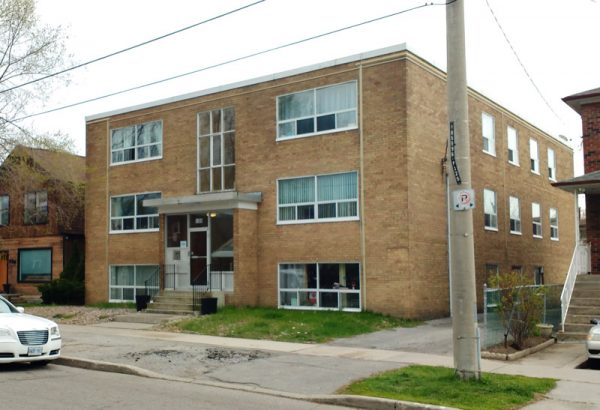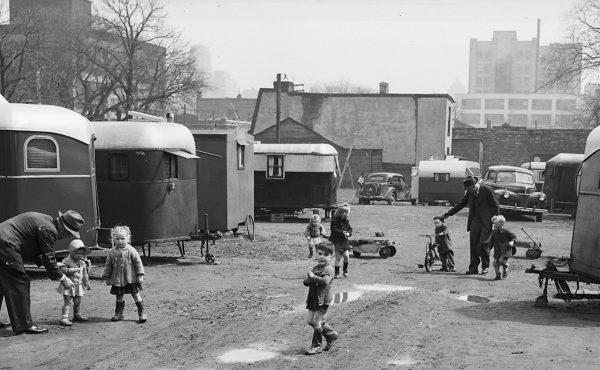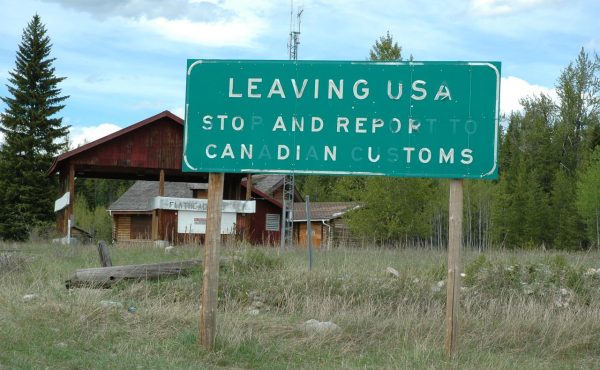Toronto is in an affordable rental housing crisis. Not only have average rents increased rapidly in recent years, but existing private affordable rental housing options are disappearing. One solution that has been initiated by some governments and non-profits is to buy those existing options to preserve them as affordable, but at present the money to do so is limited. Below, I’ll outline an idea for a housing-related source of revenue for the federal government that could be used to help address this problem, and a mechanism for how it could do so.
The disappearance of private affordable rental housing can be seen, for example, in the way divided mansions – big old houses long split up into apartments – are being re-converted into single-family homes. Meanwhile, mid-century purpose-built apartment buildings of various sizes, often somewhat run-down but therefore affordable, are being purchased by large rental corporations, who use the often genuine need for renovations to hike rental rates beyond rent control limits, or evict existing tenants and then rent out renovated apartments at much higher rates.
In some cases, both divided mansions and apartment buildings are being torn down, replaced by more but pricier condos or rental units. Increased supply is necessary to help alleviate the overall housing crisis, and can help reduce demand for upscaling other existing affordable rentals. But, unless governments play a role, private construction cannot create new affordable housing to replace what’s lost, for the simple reason that constructing new buildings is very expensive, and private builders cannot afford to build if they cannot make a profit. (One government role is inclusionary zoning rules that require large new multi-unit buildings to include a percentage of affordable housing, but they are limited in scope and the units are not always as affordable as needed).
The overall result is that between 2016 and 2021, “Toronto lost more than 130,000 rental units available at under $1,500 per month,” according to the Wellesley Institute. And many of these lost units are in locations with good accessibility to transit and services that make it easier to live on a low income.
In recent years, the City of Toronto and the federal government have finally started programs to build more affordable housing. However, if that new housing simply replaces existing private affordable housing that was lost, affordability has not been increased. In all likelihood, it cannot even keep up with the existing loss, let alone address the existing backlog and future demand. One study found that in Canada between 2011 and 2016, “for every (1) one new affordable unit created, at considerable public cost, fifteen (15) existing private affordable units (rents below $750) were lost.”
As well, even when done on a non-profit basis, building new remains very expensive, and it takes time, while the affordable housing crisis is immediate. By contrast, as one commentator notes, “it is cheaper and faster to buy older, affordable apartment buildings — and keep them affordable through co-op or non-profit ownership — than to build new from scratch.”
In recent years, the need to preserve existing affordable housing in addition to building new has started to be recognized. The grassroots land trust movement has started to take off in Toronto (PDF). It acquires existing affordable private properties in areas under pressure from rapidly increasing property prices, with the promise of maintaining that affordability. In addition to housing, these trusts and similar non-profit and co-op organizations might preserve affordable retail spaces, seniors’ housing, and artist studio spaces. These projects are generally funded by scrambling together a combination of different sources, such as section 37 money from development (which will be greatly reduced under recent Provincial changes), grants, and loans from co-operative banks.
The City of Toronto has also started to address this issue, with the Multi-Unit Residential Acquisition (MURA) program. It uses City funds to purchase affordable housing properties, preserving them for the use of non-profit housing organizations.
However, these initiatives, admirable as they are, are drops in the bucket compared to the overall size of the housing market and the pressures that are leading to the loss of affordable housing. What they lack is capital. The private owners and developers, both individual and corporate, who are driving the loss of affordable housing are able to do so because they have a lot of capital. To counter it, NGOs and governments need a source of capital that can compete.
The City does not have access to many funding tools, and any additional funding it finds would be needed for other priorities, like transit and maintenance. There are increasing calls for the federal government to develop a “national acquisition strategy that transfers rental homes at risk of losing their affordability to the non-profit sector.” But the federal and provincial governments are all under considerable fiscal constraints at the moment. To fund such a program, they would need a new source of revenue.
I am going to suggest that the federal government does have potential access to a housing-based pool of capital (it could benefit provincial governments too), which it could use to help preserve affordable housing across the country while also somewhat rebalancing housing wealth.
Where to find the money
When Canadians make money from buying things and then selling them at a profit, they are subject to capital gains tax on the profit (it is treated as part of their income, but only 50% of it is counted). However, there is one big exception – when Canadians sell their primary residence, that is, where they live, they are not subject to capital gains tax.
Some commentators have suggested removing this exemption. One issue with removing it is that most people sell their house to buy another house, often of equal or greater value. If they lose, say, 20% of the value of their house if they sell it, it will make it more difficult and less attractive to move houses for, say, a new job or a larger family. (A similar argument was made for the property transfer tax when it was introduced in Toronto. The feared effects did not transpire, but that tax maxes out at only 5% of the value and is usually less). Perhaps more significantly, given that around two-thirds of Canadian households own the property they live in, such a proposal would be extremely unpopular politically and so is unlikely to be seriously proposed by any government.
However, there is one aspect of the primary residence exemption where the one-house-for-another issue is not relevant. When a homeowner dies and passes their home on to the next generation through inheritance, their property retains the primary residence exemption. While the estate has to pay capital gains taxes on all other assets, it does not have to pay them on the primary residence. If the estate’s inheritors then sell the property, they do have to pay capital gains – but only on the difference between the assessed value of the property at the time of death and the value when it’s sold. If it’s sold within a year or two, that might be little or nothing after other deductions. So selling a million-dollar property might result in just a few thousand dollars in capital gains taxes.
The result is a windfall for the inheritors. Often, given the average age of death in Canada, those inheritors will be middle-aged and already own their own home. If they don’t, the inheritance will give them a big leg up in joining the ranks of homeownership. Unlike a living homeowner, these inheritors do not need the full capital from the sale in order to replace one home with another.
Over the next few decades, a massive amount of very valuable real estate will be passed down from baby boomers who first bought property when prices were low to their children and perhaps grandchildren, solidifying their family’s place among homeowners and making it all the harder for those not fortunate enough to inherit property to get on the property ladder.
If the federal government eliminated the inheritance aspect of the primary residence exemption, it could raise a significant amount of money. I don’t have the expertise to calculate the exact figure, but if we imagine an average of 20% of the value of all inherited primary residences every year, it is many millions of dollars a year.
One way to eliminate the exemption could be to have it expire after the death of the last occupant (so that spouses aren’t affected), so that the estate has to pay capital gains on the primary residence. The complicated process of winding up an estate could create difficulties for estates with limited funds other than the value of the home, though. A simpler solution might be to decide that any subsequent sale of the property by the inheritors calculates the capital gains based on the original price paid for the house by the deceased, not the deemed price at death. Tax experts would be best placed to figure out the details and which option is better, but the change certainly seems possible.
While this change wouldn’t be popular – no new taxes are – it would not have the same kind of immediate impact on homeowners, so might be more politically viable.
In addition to raising money, eliminating the exemption would go a small way to reducing inequality in the housing market, by shaving off at least some of the windfall received by families fortunate enough to have a parent who benefitted from the enormous increase in value of housing in recent decades and thus reducing their advantage over families that have not been so fortunate.
How to use the money
I propose that the federal government set aside the funds raised by this housing-oriented tax change to help preserve existing affordable rental housing (as well as perhaps funding new affordable housing) across Canada.
The federal government could rely on non-profits and municipal government housing agencies to identify affordable rental housing that they want to preserve. When suitable properties are identified and an organization is willing to manage it, the federal government (probably through an agency created for this purpose) would buy the property, and then lease it out to the non-profits or agencies for a nominal dollar-a-year, on condition that it remain affordable. That way, the affordable housing organizations are not burdened by the capital costs of the property. They can use the (affordable) rental income to fund the maintenance and renovation of the property without having to cover purchase carrying costs.
With access to a much larger pool of money, land trusts, housing co-ops, other NGOs, and municipal housing agencies could afford to secure a much more significant proportion of the private affordable rental housing stock that is in danger of being lost, including larger apartment buildings that would otherwise be beyond their reach. They would be able to make a significant difference to maintaining rental housing affordability in Canada.
The federal government would have no role in administering these properties – it would simply be the underlying owner and set the basic affordability requirements. Its fiscal muscle would enable local initiatives without getting entangled in them, giving locals the flexibility to identify the best course of action that suits their location.
A side benefit of this model would be that the citizens of Canada, through their federal government, would build up a portfolio of property owned by all citizens. At the moment, property is owned by individuals and by those wealthy enough to own shares in Real Estate Investment Trusts or other property holders. A significant number of Canadians have no share in that wealth. Having a pool of property owned by all Canadians – even if it didn’t generate income – would help balance out that property wealth. And using property wealth to support renters would help shift the disproportion in wealth between homeowners and renters.
If we are going to maintain some measure of affordability in our cities, we need to act fast. With increasing income and wealth inequality over recent decades, an expanding pool of concentrated capital, both individual and corporate, is being used to buy up the best-located affordable rental housing in Canadian cities. As well, a huge transfer of wealth will be happening over the upcoming decades as the children of property-owning baby boomers inherit. The plan outlined above both helps to somewhat balance out that wealth, and redirects it to give governments the capital necessary to help non-profits and municipal governments preserve enough affordable rental housing to make a long-term difference.






4 comments
I just appreciate the picture of the 3-storey on Sammon Ave
Thank-you for discovering a “windfall” for inheritors, who you assert have no need of it. Based largely on your notion long held family property in Toronto was originally cheap, forgetting 16% mortgages and inflationary dollar values, you characterize a family asset as fair game to savage, into the warm care of the federal government for the benefit of (fill in the blanks). So that they can rent forever, rarely an observable ambition on the street.
Comments on “a portfolio of property owned by all citizens” exceed my typing energy as you apparently assume residents of Toronto’s existing public housing developments inhabit a rent-controlled paradise, yet urge more of the same. Leave your laptop and talk to a few about that gritty utopia.
I like spacing.ca as usually and sensibly discussing urban issues, was long in the trenches myself, but now wonder, is there an editor in the house?
Hear the voice of NIMBY Toronto, where the “family asset” is sacrosanct! 16% mortgages were three decades ago. House prices have far outstripped inflation since. Inflation is one reason why only 50% of capital gains are taxed. Most people have to rent before they own. And if they rent forever, it’s because they can’t afford to own. But apparently such people are not worthy of consideration.
This article, published a couple of weeks after this post, summarizes the need and the potential well: “Meet Your New Landlord: a Local Non-Profit,” https://thelocal.to/neighbourhood-land-trust-affordable-housing-toronto/